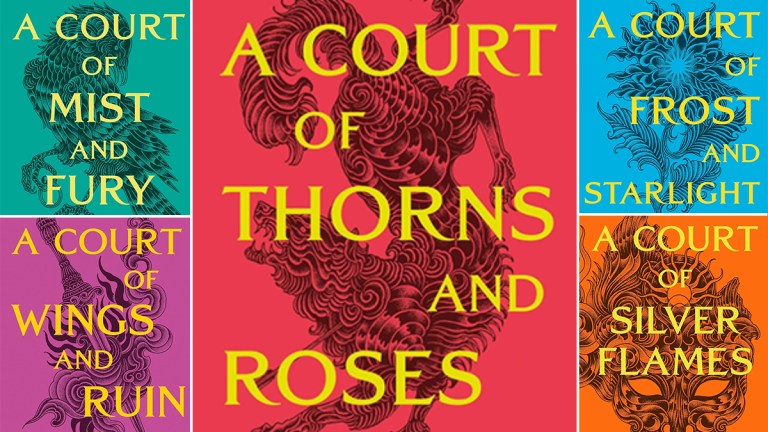The ACOTAR TV Show Could Be the Biggest Fantasy Series Since Game of Thrones
Get ready to hear a lot more about Sarah J. Maas' A Court of Thorns and Roses

If you’ve paid any attention to the fantasy fiction section of your local bookstore, you’ve probably heard of Sarah J. Maas. Her books have sold over 13 million copies, she’s a fixture at the top of the New York Times bestseller list, and her complex stories have given rise to the sort of rabid fandom that lends itself to eager YouTube discourse, complicated reader theories about its characters and larger universe, and a bustling Etsy economy of assorted themed fan-made products. People that love Maas’s books, love her books. People who don’t love her books…probably just haven’t read them yet.
Though her first series, Throne of Glass, was published in 2012, it wasn’t until her second, A Court of Thorns and Roses began in 2015 that she became a crossover sensation. Thanks to its feisty heroine, its Beauty and the Beast-inspired narrative framing, and the rich, emotional complexity and interiority she gifts her female characters, the ACOTAR novels drew in not just YA and fantasy readers, but more mainstream lovers of romance. The ACOTAR hashtag on TikTok currently boasts over 8.5 billion views, and Maas herself has 1.5 million followers on Instagram, well beyond any other popular author of romantic fantasy. (Yes, even Rebecca Yarros, whose Fourth Wing is feels like it’s everywhere at the moment.)
The A Court of Thorns and Roses Books
The A Court of Thorns and Roses series currently spans five books, most of a doorstopper size J.R.R. Tolkien might approve of, with at least two more on the horizon. (Though Maas has been rather cagey about which characters the forthcoming installments will spotlight.) While some corners of the publishing world (and, unsurprisingly, the internet) deride her works for being too focused on traditionally female themes like love and sex, Maas’s books are surprisingly thoughtful explorations of healing and self-acceptance, in which her heroines’ embrace of their true selves is every bit as important as finding a romantic partner or saving the world.
A Court of Thorns and Roses ostensibly follows the story of Feyre Acheron, who accidentally kills a fairy wolf to feed her starving family. When an ancient treaty demands a life for a life in return for the one she thoughtlessly took, she chooses to journey to the magical kingdom of Prythian where she’ll essentially live as a prisoner of the mysterious beast-like creature known as Tamlin. As any regular reader of fantasy will have already guessed, that’s only the beginning of the sprawling, complex saga that follows, which involves everything from fairies and royal courts full of magic tied to specific seasons and times of day, to ancient curses, fated lovers, and dense political intrigue.
Bringing ACOTAR to the Screen
Given its massive popularity, it’s not going to surprise anyone that there have already been attempts to bring the story of Feyre and friends to life. Tempo optioned the film rights in 2015 and the project progressed to the point where Maas herself teased an early look at the script, which was written by Rachel Hirons. However, the film adaptation eventually sputtered out, and if we’re honest, it’s probably for the best. While it’s thrilling to imagine the version of Prythian that might be created by big studio movie budgets, the run time of even the longest potential feature film would require some serious condensing of the original text in a way that would almost certainly leave out key moments or characters.
Thankfully, in 2021, it was announced that streamer Hulu was working on a TV adaptation of ACOTAR with Ronald D. Moore of Outlander and Battlestar Galactica fame, alongside Maas herself, who was reportedly co-writing the pilot. Development on the series has been relatively slow in the three years since this initial announcement, and although Maas confirmed as recently as last summer that she was still working on the script, she has also deleted the Instagram post that originally announced the series to her fans. What does all this mean? Probably nothing, given that last summer also saw both the Writers Guild of America and the Screen Actors Guild go on strike and there’s every chance Maas simply deleted her post in solidarity.
This theory is borne out by comments from Moore himself, who confirmed the series was still in development last November, but admitted that they were “all just sort of waiting” to see how the strikes would end. (Interestingly enough, Moore’s TV Line interview took place just days before the actors’ strike concluded so fingers crossed the waiting is over by this point.)
Why ACOTAR Is the Perfect Next Step for Fantasy TV
The truth is ACOTAR has always made more sense as a television series, where its sprawling cast of characters and complicated plot can have the room to breathe they deserve. But also because our current fantasy television landscape desperately needs a show like ACOTAR.
Maas’s books are wildly popular due to their dense plotting, steamy romances, and rug-pulling narrative and emotional twists. But where her works differ from many of the other big-name fantasy series of the day (looking at you, George R.R. Martin), is how explicitly female-focused they are. The ACOTAR series not only features a female lead, but a squad of a half dozen other women around her, each with stories, agency, and relationships of their own. (Nesta, Feyre’s sister, is even the primary protagonist of one of the later ACOTAR novels.) Maas’s books feature plenty of sex and romance but lack the lurking threat of sexual menace that permeates so much of the world of high fantasy, both on the page and onscreen. There’s no rape and most sexual encounters occur between a set of fated partners, tied together by not just desire, but love and destiny, their romance a crucial piece of the endgame of the larger story the books are telling.
For all Maas’s reputation as the undisputed queen of the “romantasy” genre—the publishing term for books that simultaneously embrace epic love stories right alongside their dense fantasy plots without sacrificing the quality of either—her novels are uniquely grounded in a very specific female experience. Yes, Feyre must ultimately work to save Prythian from an ancient evil, but at its heart, these books are about how its heroine learns to save herself. ACOTAR is as much a story of healing and self-acceptance as it is a magical adventure, and in order to save the world, Feyre must first confront the pain and trauma that’s holding her back. Power in Maas’ world doesn’t often come in the form of a sword or a magical talisman. Instead, it often looks a whole lot like forgiveness, peace, and self-knowledge.
These are precisely the sorts of stories that television as a medium is uniquely equipped to explore. Multiple seasons of an ACOTAR show would not only be able to more accurately convey the sheer scope of Maas’s fictional world and its characters, but give each of its fascinating women and their individual stories the focus they deserve. And in an entertainment landscape that’s already shown us plenty of male-centric fantasy stories, it’s past time for one that’s unabashedly about and for women. From Feyre’s sisters Nesta and Elain to Morrigan, the sultry but powerful third in command of the Night Court to the mysterious and vaguely monstrous Amren, the ACOTAR universe is one that’s powered by the emotional journeys of women—no matter how attractive Tamlin, Rhysand and the story’s leading men might happen to be, and that’s precisely the kind of fantasy our screens could use more of.

